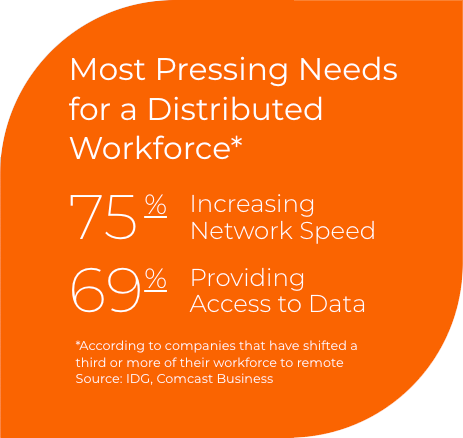Can Technology Turn Remote Work Into a Competitive Advantage?

By embracing at-home connectivity and collaboration, businesses compete for anew talent, improve performances and build stronger cultures

The expansion of remote work has been tremendously accelerated by the pandemic, and it’s now become apparent that a large distributed workforce will remain a sustained business reality. Recent surveys of hiring managers show that in 2021, many organizations expect to permanently increase their remote workforce to between one-quarter and one-third of workers.
Today, companies have turned their attention from simply ensuring business continuity to strategizing how they can best support remote employees with advanced networking technology—and make their remote workforce a competitive differentiator.
Studies have shown a range of benefits of a distributed workforce. Remote work enables more flexibility and reduced commute time, improving work-life balance and morale, which has a positive influence on productivity and employee retention. Remote work also expands access to a broader talent pool, which levels the geographic advantage of metropolitan talent centers and creates a more inclusive and accessible work culture. Less reliance on centralized office space can also create capital cost savings and reduce corporate environmental impact.
With the right networking technology, companies can set up remote workers with the same reliable, secure access to information and communication tools as office workstations. Glenn Katz, SVP and General Manager of Comcast Business Enterprise Solutions, says that he is “seeing a huge demand spike” from companies moving to a distributed workforce or a hybrid of on-premise and remote work. The company is receiving “more requests to help upgrade aging infrastructure to more advanced, secure high-speed broadband to support the dramatic increase in home workers.”
How companies are re-architecting their networks to support the new work-from-anywhere business world
An April analysis by the nonprofit National Bureau of Economic Research found that about 40% of jobs could be done remotely. Companies are renovating their networks to support the new remote reality by digitalizing processes, moving data and applications to the cloud and utilizing cutting-edge collaboration platforms. “People that normally didn't work at home have found that you can actually do business in this manner and be a bit more efficient,” says Katz. “And that efficiency is getting work done without having to spend time moving between offices and areas within your building.”
Truly unlocking the potential of a distributed workforce requires the right network underlay, effectively extending the office into the home. This often requires increasing home internet bandwidth so access to data, applications and communication tools is reliable, secure and fast, whether accessing cloud applications directly or connecting to the enterprise network for more sensitive applications via a VPN.
How CIOs architect networks to optimize remote work will likely depend on the type of work, the level of security and access to data that is needed and the complexity of the applications used by individual workers. Managing these new and evolving requirements efficiently will in part depend on the agility of corporate networks. For example, SD-WAN can simplify routing of network traffic, update networks resources centrally and monitor networks remotely in the event of an issue, as well as easily setting access and security policies across locations.
Work From Home Works for Some
Share of jobs that can be done at home, by industry
Educational services
Professional, scientific and technical services
Management
Finance and insurance
Information
Wholesale trade
Real estate
Source: Bloomberg/National Bureau of Economic Research
As remote work accelerates, robust connectivity to a data center or clouds - or both - remains crucial
The network and cloud tie together a company’s data, applications and dispersed workers. To optimize remote work during and after the pandemic, many companies have already accelerated their digital transformation, often shifting more work applications to the cloud.
“It doesn’t matter whether remote employees are accessing applications in the cloud or a private data center — that access requires fast, reliable and secure internet connections,” Katz points out. “We’ve been doing this with branch locations for many years, and now we’re taking that same network technology and putting it into people’s homes. That digital transformation that started with branches is basically moving into the remote worker space.”
Remote work models are changing how enterprises think about cybersecurity
Home workers in various roles have different technology and security requirements. Most large companies have three levels of employees: the executive level, middle to upper management and rank-and-file employees.
“For the rank-and-file, they may be using their own equipment, but the company pays for a business line that provides hundreds of megabits per second,” Katz explains. “The mid-level group may require access to secure information and require access to multiple systems within the enterprise. They need the business line, but also a secure network appliance, such as a VPN with Wifi. At the highest levels, a fiber Ethernet connection may be needed for even more reliable, secure service.”
While the technology needed to support enterprise security will need to evolve to support remote work, the human element is still critical. People must continue to exercise vigilance and caution and observe security protocols, whether they are working in an office or remotely on their personal devices. Thus, cybersecurity hygiene and best practices are especially emphasized for the distributed workforce.
“The weakest link in cybersecurity will always be individuals, and someone clicking on an email,” says Katz. “That doesn’t change whether you’re inside the building or you’re on the network with an external appliance. But a vulnerability can be exaggerated when you’re working from home on residential Wifi and you have a weak password. If someone can hack into that home network, then they can splice into your enterprise network. That’s a really big concern, and why it’s so important for companies to provide a computer that is monitored and secured.”
IT budgets are shifting to support more rapid digitalization and the expansion of remote work
37%
of jobs in the Unided States can be performed entirely at home.
Source: National Bureau of Economic Research
Many businesses are currently in high gear to accelerate digitalization and network upgrades to support remote workers. Recent research by IDG shows that the most pressing needs for companies expanding their remote workforce are increasing network speed and providing access to data. And despite the continued economic uncertainty, the rapid and sustained shift to remote work and the growth of digital business initiatives in general have cast digital transformation efforts in a new light.
“Right now, CIOs have the spotlight on them,” says Katz. “It used to be that they would struggle to get budget dollars for new applications or the physical infrastructure to help with digital transformation. But they are getting a lot more funding now."
As the remote workforce expands, network architectures and security must evolve to meet the needs of an increasing number of workers in diverse locations. More rapidly than ever before, networks are being reconfigured to fully realize the goal of fast, reliable and secure connectivity within home offices. Those companies that do it well stand to gain a competitive upper hand in the work-from-anywhere era.
By embracing at-home connectivity and collaboration, businesses compete for anew talent, improve performances and build stronger cultures
Locked Content
Click on the button below to get access
Unlock NowOr sign in to access all content on Comcast Business Community
Learn how Comcast Business can help
keep you ready for what's next.





